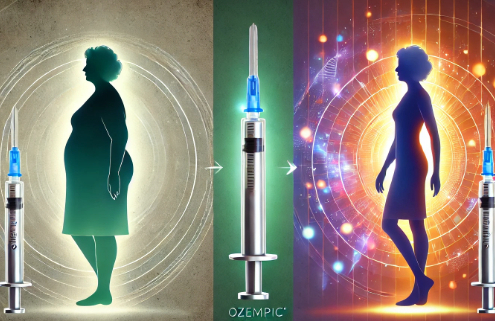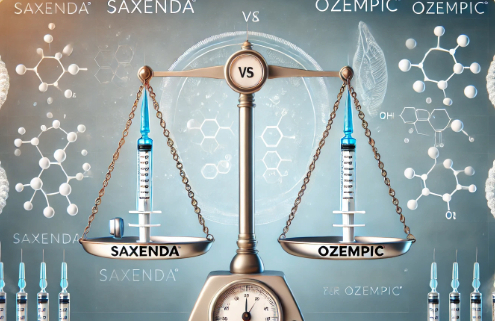GLP-1 Medications: Weight Loss, Health Benefits, and How to Choose the Right Option
GLP-1 medications, short for glucagon-like peptide-1 receptor agonists, have become a cornerstone in the management of obesity and certain chronic health conditions.
Here at SANEMD.com we strive to give our readers the best possible weight loss resources and education. Make sure to scope out all of our resources pages and articles while you’re here with us!
GLP-1 Intro
Originally developed to help control blood sugar levels in individuals with type 2 diabetes mellitus, these medications are now widely recognized as effective diabetes medicines for both blood sugar control and weight loss.
Their dual benefits have made them a popular choice for addressing both weight-related and metabolic health issues.
These medications work by mimicking the natural hormone GLP-1, which regulates appetite, blood sugar, and digestion.
In addition to promoting weight loss, they help manage conditions like diabetes, high blood pressure, and cardiovascular disease, all of which are closely tied to excess weight.
We will provide a comprehensive overview of GLP-1 medications, diving into the science behind how they work, their potential benefits, and how to choose the most suitable option for your health goals.
Whether you’re exploring these medications for weight loss or other health concerns, understanding their mechanisms and applications is key to making an informed decision.
Key Takeaways
- GLP-1 medications mimic a natural hormone that helps regulate appetite and blood sugar levels.
- They are used for weight loss and to manage conditions like type 2 diabetes and heart disease.
- The choice of medication should be based on one’s Weight Loss Drug Type, individual health needs, and professional medical guidance.
- Understanding the science and benefits of GLP-1 drugs can empower informed decision-making.
What Are GLP-1 Agonists?
GLP-1 medications, also known as GLP-1 agonists, belong to a specific drug class designed to mimic the natural hormone glucagon-like peptide-1 (GLP-1).
Definition and Mechanism of Action
This hormone is produced in the gut and plays a critical role in regulating several key processes, including appetite, blood sugar control, and digestion.
When you eat, GLP-1 signals the brain to reduce hunger, slows the movement of food through the stomach, and stimulates the pancreas to release insulin.
Together, these actions help control calorie intake, lower serum glucose levels, manage blood sugar levels, and improve metabolic function.
GLP-1 receptor agonists replicate the effects of this hormone by binding to GLP-1 receptors in the body.
These medications are engineered to remain active longer than the naturally occurring hormone, providing sustained benefits like:
- Appetite suppression: Reducing hunger and cravings.
- Delayed gastric emptying: Slowing digestion to increase feelings of fullness.
- Improved insulin response: Enhancing the body’s ability to regulate blood sugar levels.
Additionally, GLP-1 agonists may help reduce the progression of chronic kidney disease (CKD) and may be recommended for patients suffering from this condition.
Approved Uses
GLP-1 medications are approved by the U.S. Food and Drug Administration (FDA) for specific medical conditions. The primary indications include:
- Type 2 Diabetes Management: These drugs help control blood sugar levels and improve insulin sensitivity.
- Chronic Weight Management: Some GLP-1 medications, such as Wegovy®, are approved for use in compatible individuals with obesity or those with weight-related medical conditions.
Off-Label Uses
While their FDA-approved uses are well-defined, GLP-1 receptor agonists are increasingly prescribed off-label for related conditions.
These include preventing the progression of prediabetes and assisting with weight management in individuals who do not meet the strict criteria for obesity but may benefit from moderate weight loss.
Off-label use should always be guided by a healthcare provider to ensure safety and efficacy.
The Science Behind GLP-1 Medications
GLP-1 medications have gained recognition for their effectiveness in facilitating weight loss. They work by targeting the body’s appetite-regulation system, primarily the hypothalamus, which controls hunger and satiety signals.
Impact on Weight Loss
By mimicking the GLP-1 hormone, these drugs help individuals lose weight by suppressing appetite, reducing cravings, and slowing gastric emptying, making individuals feel full for longer periods.
As a result, calorie intake decreases without the need for extreme dietary restrictions.
Clinical trials have shown the exceptional weight-loss potential of GLP-1 medications.
For example, studies on semaglutide (sold under brand names like Wegovy® and Ozempic®) show that participants lost an average of 10–15% of their body weight over a year.
These results often exceed those achieved through diet and exercise alone, making GLP-1 receptor agonists a valuable tool for individuals struggling with obesity or weight-related health issues.
Other Health Benefits
1. Diabetes Management
GLP-1 medications were initially developed for the treatment of type 2 diabetes mellitus, and their impact on blood sugar regulation remains one of their primary benefits.
These drugs enhance the body’s insulin response after meals, helping to lower serum glucose levels.
Additionally, they inhibit the release of glucagon, a hormone that raises blood sugar.
Clinical evidence shows significant reductions in A1C levels, often by 1–2 percentage points, which can help prevent complications of diabetes.
2. Heart Health
Beyond weight loss and diabetes control, GLP-1 medications also support cardiovascular health.
Research indicates that GLP-1 medications can lower the risk of significant cardiovascular events, including heart attacks and strokes, particularly in individuals with type 2 diabetes and existing heart conditions.
This benefit is thought to result from their positive effects on weight, blood pressure, and cholesterol levels.
3. Other Metabolic Conditions
GLP-1 medications have shown promise in improving other metabolic markers, including:
- Cholesterol Levels: Reducing LDL (bad cholesterol) and triglycerides while raising HDL (good cholesterol).
- Liver Health: Reducing fat accumulation in the liver, which may benefit individuals with non-alcoholic fatty liver disease (NAFLD).
Side Effects and Safety Considerations
1. Common Side Effects
Although GLP-1 medications are generally well-tolerated, they may cause side effects, especially during the initial weeks of treatment. These include:
- Nausea
- Vomiting
- Diarrhea or constipation
- Abdominal discomfort
These effects often subside as the body adjusts to the medication.
2. Rare but Serious Risks
In rare cases, GLP-1 receptor agonists may lead to serious health concerns, such as:
- Pancreatitis: Inflammation of the pancreas, which can cause severe abdominal pain.
- Thyroid Concerns: A potential risk of thyroid tumors has been observed in animal studies, though this remains unconfirmed in humans.
- Kidney Injury: Acute kidney injury can occur due to volume contraction, necessitating careful monitoring and dosage adjustments.
3. Suitability
Not everyone is a candidate for GLP-1 medications. Individuals with a history of the following conditions should avoid these drugs or consult their healthcare provider:
- Medullary thyroid cancer or a family history of the condition.
- Pancreatitis or gallbladder disease.
- Severe gastrointestinal disorders.
Pregnant or breastfeeding individuals should also avoid these medications, as their safety in these groups has not been established.
Comparing GLP-1 Medications
GLP-1 receptor agonists are available in several formulations, each with specific indications and benefits. The importance of body mass index (BMI) in determining eligibility for these medications cannot be overstated.
Overview of Available Medications
A subset of individuals with a BMI of 30 or higher, or those with a BMI of at least 27 with related health conditions, are typically considered for treatments like semaglutide and Wegovy.
Here’s a look at some of the most used options:
1. Wegovy® (semaglutide):
- Indication: FDA-approved for chronic weight management in individuals with obesity or overweight with at least one weight-related condition (e.g., hypertension, diabetes).
- Details: Wegovy is administered once weekly and is specifically tailored for weight loss. Clinical trials show an average weight loss of around 15% of body weight over 68 weeks.
2. Ozempic® (semaglutide):
- Indication: Primarily used to improve blood sugar control in type 2 diabetes but often prescribed off-label for weight management.
- Details: Like Wegovy, it is a once-weekly injection with similar mechanisms and weight loss effects, though its primary approval is for diabetes.
3. Saxenda® (liraglutide):
- Indication: Approved for chronic weight management and type 2 diabetes.
- Details: Saxenda requires daily injections. Weight loss effects are slightly less pronounced compared to semaglutide-based medications, with studies showing an average of 5–10% of body weight reduction.
4. Other Options:
- Trulicity® (dulaglutide): Approved for type 2 diabetes but sometimes used off-label for weight loss.
- Bydureon® (exenatide): A weekly injection approved for blood sugar control in diabetes with some impact on weight.
- Mounjaro™ (tirzepatide): Though not a GLP-1 receptor agonist alone, it mimics both GLP-1 and another hormone (GIP), showing exceptional weight loss results in clinical trials.
Key Differences Between Medications
- Dosage and Administration:
- Daily Injections: Saxenda is administered daily, which may suit individuals who prefer smaller, consistent doses but can be inconvenient for others.
- Weekly Injections: Wegovy, Ozempic, and Trulicity offer once-weekly administration, making them more convenient for many users.
- FDA-Approved Uses vs. Off-Label Benefits:
- Some medications, like Wegovy and Saxenda, are explicitly approved for weight management, making them the preferred choice for obesity treatment.
- Others, such as Ozempic and Trulicity, are approved for type 2 diabetes but frequently prescribed off-label for weight loss due to their efficacy in reducing body weight.
- Cost and Insurance Coverage:
- GLP-1 medications are often expensive, with costs ranging from several hundred to over a thousand dollars per month.
- Insurance coverage varies significantly depending on the medication, its approved use, and individual insurance policies. Medications like Ozempic may have better coverage for diabetes management but not for off-label weight loss.
Choosing the Right Medication for You
Selecting the most suitable GLP-1 medication depends on several factors.
Here are key considerations to help guide the decision:
- Health Goals:
- If weight loss is the primary goal, medications specifically approved for obesity, such as Wegovy or Saxenda, may be the best option.
- For those managing type 2 diabetes with weight loss as a secondary goal, Ozempic or Trulicity may be appropriate.
- Pre-Existing Conditions:
- Individuals with specific health concerns, like cardiovascular risks or a history of pancreatitis, should consult with their doctor to ensure the chosen medication aligns with their medical history.
- Those with thyroid concerns, particularly a family history of medullary thyroid cancer, should avoid GLP-1 medications due to potential risks.
- Lifestyle and Preferences:
- Weekly injections, such as Wegovy or Ozempic, offer convenience for those with busy schedules, whereas daily injections like Saxenda may suit those who prefer consistent doses.
- Lifestyle factors, including dietary habits and physical activity levels, can also influence how effective these medications are.
- Cost and Accessibility:
- Discussing insurance coverage and affordability with a healthcare provider can help identify the most cost-effective option.
- Patient assistance programs offered by manufacturers may also reduce costs for eligible individuals.
- The Role of Healthcare Providers:
- A healthcare provider can assess your overall health, medical history, and goals to recommend the most appropriate GLP-1 medication.
- Regular follow-ups are essential to monitor progress, manage potential side effects, and make adjustments if necessary.
How GLP-1 Medications Support Weight Management
One of the foundational uses of GLP-1 medications is their ability to improve blood sugar control, making them a mainstay in the management of type 2 diabetes mellitus.
Diabetes and Blood Sugar Control
These drugs enhance the body’s natural insulin response by increasing insulin production when glucose levels are high, helping to lower post-meal blood sugar spikes.
Simultaneously, they suppress glucagon, a hormone that raises blood sugar, leading to improved overall glucose regulation.
GLP-1 medications also slow the rate at which food leaves the stomach, reducing the risk of rapid blood sugar increases.
This mechanism is particularly beneficial for people at risk of or currently managing insulin resistance, a key factor in the development of type 2 diabetes.
For individuals at high risk of developing diabetes, GLP-1 drugs may also help delay or prevent the progression of the condition.
By promoting weight loss and improving metabolic health, these medications address key contributors to diabetes onset, offering a proactive approach to prevention.
Heart Health
GLP-1 medications not only aid in weight loss but also contribute to cardiovascular health.
Obesity and type 2 diabetes are closely linked to increased risks of heart disease, including high blood pressure, elevated cholesterol, and inflammation.
By targeting these underlying factors, GLP-1 drugs provide significant cardioprotective benefits.
Studies have demonstrated that GLP-1 receptor agonists can lower blood pressure and improve cholesterol levels by reducing LDL (bad cholesterol) and triglycerides while increasing HDL (good cholesterol).
These changes contribute to a healthier lipid profile and reduced strain on the cardiovascular system.
One of the most significant advantages of GLP-1 medications is their ability to reduce the risk of major cardiovascular events, such as heart attacks and strokes, especially in individuals with type 2 diabetes and existing heart conditions.
Clinical trials for drugs like semaglutide and liraglutide indicate a measurable reduction in these risks, making them valuable for individuals managing both weight and cardiovascular health.
Psychological Benefits
The impact of GLP-1 medications extends beyond physical health, often leading to improved mental and emotional well-being.
Excess weight and associated health conditions can negatively affect self-esteem, body image, and overall mental health.
The weight loss achieved with GLP-1 medications, which are used to treat obesity, often enhances self-confidence and quality of life.
Additionally, GLP-1 drugs may help address food-related behaviors that contribute to weight gain, such as binge eating or overeating.
By suppressing appetite and reducing cravings, these medications provide users with better control over their eating habits, fostering healthier relationships with food.
The psychological benefits of GLP-1 medications are closely tied to their overall effectiveness in weight and health management.
By supporting both physical and emotional health, they offer a holistic approach to improving the quality of life for individuals struggling with weight-related conditions.
Addressing Misconceptions
Some individuals worry about long-term dependence on GLP-1 medications or the return of weight after discontinuing them.
While weight regain is possible if the underlying causes of weight gain are not addressed, combining these medications with lifestyle changes can provide sustainable benefits.
Ethical Concerns
One significant issue surrounding GLP-1 medications is their high cost, which can make them inaccessible to many people.
1. Availability and Affordability
Monthly expenses can range from hundreds to over a thousand dollars, depending on the medication and insurance coverage.
For individuals without insurance or adequate coverage, the financial burden can be prohibitive, raising concerns about equitable access to these potentially life-changing treatments.
2. Non-Medical Use
As GLP-1 medications gain popularity for weight loss, some individuals without medical indications for their use may seek prescriptions.
This trend can lead to shortages for patients who need these medications for conditions like type 2 diabetes or obesity-related health issues.
The off-label use for cosmetic weight loss also raises ethical questions about prioritizing medical necessity over aesthetic goals.
3. Societal Pressures and the Role of Medications
The increasing reliance on medications like GLP-1 receptor agonists for weight loss reflects broader societal pressures to conform to certain body standards.
While these medications offer significant health benefits, their use should be framed around improving health and quality of life rather than achieving unrealistic ideals.
Encouraging a balanced approach that includes lifestyle changes alongside medication is essential to mitigate the risk of over-reliance on pharmacological solutions.
FAQs About GLP-1 Medications
With the growing interest in GLP-1 medications for weight loss and health management, many people have questions about how these drugs work, their safety, and their long-term impact.
Addressing these common concerns can help individuals make informed decisions about whether these medications are right for them.
1. How quickly do GLP-1 medications work?
The timeline for seeing results with GLP-1 medications varies by individual and depends on factors like dosage, adherence, and overall health.
Most people begin to notice reduced appetite and initial weight loss within the first few weeks of treatment.
Significant weight loss and improved metabolic markers, such as lower blood sugar levels, are often observed after several months.
Clinical studies show that individuals may achieve their full weight-loss potential within 6–12 months of consistent use.
2. Are GLP-1 drugs safe for long-term use?
GLP-1 medications are generally considered safe for long-term use when prescribed and monitored by a healthcare provider.
Long-term studies have demonstrated sustained benefits for weight management and improved metabolic health, including better blood sugar control and reduced cardiovascular risk.
However, ongoing monitoring is essential to manage any potential side effects or complications, such as gastrointestinal discomfort or, in rare cases, pancreatitis.
Patients should work closely with their healthcare provider to evaluate the risks and benefits over time.
3. Can these medications be used without a diabetes diagnosis?
Yes, certain GLP-1 medications are approved for weight management in individuals without diabetes.
For example, Wegovy® is specifically indicated for chronic weight management in individuals with obesity or those who are overweight with at least one weight-related condition, such as high blood pressure or sleep apnea.
While off-label use is possible, it is essential to consult a healthcare provider to ensure the medication is appropriate for your health goals and medical history.
4. Do I need to follow a special diet while taking GLP-1 medications?
There is no strict dietary requirement for individuals using GLP-1 medications, but maintaining a balanced, healthy diet can enhance their effectiveness.
A diet rich in lean proteins, legumes, fruits, and vegetables supports weight loss and metabolic health.
It’s also important to avoid overeating or consuming large, high-fat meals, as this can increase the risk of gastrointestinal side effects.
Your healthcare provider or a registered dietitian can help you develop a dietary plan tailored to your needs.
5. What happens if I stop taking the medication?
Discontinuing GLP-1 medications may lead to weight regain and a return of previous metabolic issues, such as elevated blood sugar levels if the underlying causes of weight gain or insulin resistance are not addressed.
This is because these medications manage symptoms rather than cure the root causes of obesity or metabolic dysfunction.
To minimize weight regain, it’s essential to adopt sustainable lifestyle changes, including regular physical activity and a healthy diet, during and after treatment.
Conclusion
GLP-1 medications have revolutionized the approach to weight loss and the management of weight-related health conditions.
By mimicking the body’s natural hormone to regulate appetite, blood sugar, and digestion, these drugs offer a scientific and targeted method for achieving significant health improvements.
Their dual benefits for weight loss and metabolic health make them a promising option for individuals with obesity, type 2 diabetes, or other related conditions.
However, choosing the right GLP-1 medication requires careful consideration of individual health goals, medical history, and lifestyle factors.
While these drugs are effective, they are not a one-size-fits-all solution.
Consulting with a healthcare provider is essential to determine which medication aligns best with your needs and to ensure safe and responsible use.
When combined with sustainable lifestyle changes, GLP-1 medications can provide long-term benefits, helping individuals achieve healthier weights and reducing risks for chronic diseases.
By understanding the science, benefits, and potential risks, you can make an informed decision and take a significant step toward improved health and well-being.
References
- Wilding, J. P., et al. (2021). “Once-Weekly Semaglutide in Adults with Overweight or Obesity.” The New England Journal of Medicine. Link
- Marso, S. P., et al. (2016). “Liraglutide and Cardiovascular Outcomes in Type 2 Diabetes.” The New England Journal of Medicine. Link
- American Diabetes Association. (2023). “Pharmacologic Approaches to Glycemic Treatment.” Standards of Medical Care in Diabetes. Link
- U.S. Food and Drug Administration. “GLP-1 Receptor Agonists Overview.” Link
- Rubino, D. M., et al. (2022). “Weight Loss with Tirzepatide versus Semaglutide in Non-Diabetic Adults.” Diabetes, Obesity and Metabolism. Link
Stay Informed With Our GLP-1 Medication Educational Resources Below:










